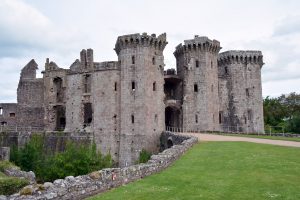
If Wales was a house for sale, estate agents might well describe it as ‘compact and bijou’. The country has been subjugated by neighbourhood tyrant England for centuries. And there are four times as many sheep here as people.
Yet for such a diminutive and under-populated country, Wales certainly packs a lot of punch. Commonly known as the ‘Land of Song’, Wales has many things that make it tantalisingly unique. Here’s our pick of the best.
1. Castles

Okay so castles aren’t unique to Wales, but there are more castles per square mile here than anywhere else in the world, stony testament to the bloody history of this much-besieged country. There are over 600 castles in Wales. Some of them have been ravaged by time and the assaults of Celt, Roman, Saxon and Viking marauders. These ones verge more on the ransacked and desolate end of the spectrum, but many others still stand proud, commanding the skyline. That’s a whole heap of turrets, dungeons and belfries to explore.
2. The Red Dragon
The winged red dragon, with its arrow-head tongue and tail, is a much-loved symbol of Wales. It sits glowering upon the white and green background of the Welsh flag. The dragon’s first appearance on the Welsh flag was at the Battle of Bosworth Field in 1485, when Henry Tudor defeated Richard the Third. The mists of time obscure the original meaning behind the dragon as an emblem. Some say that its origins lie in Arthurian legend, linking it to a dream that Merlin had where the native Britons, represented by a red dragon, fought the invading Saxons, represented by a white dragon, and won. Others think that the dragon was one of the many things ‘that the Romans did for us’, as the dragon was symbolic of the basic military unit of the Roman army.
3. Men With Odd shaped balls

Today, rugby is played in over 100 countries worldwide, but the sport has its origins in England and Wales and is at the heart of Welsh national identity. Rugby legend Gareth Edwards described the game as “part of the DNA of Welshmen”. The Welsh had ancient games with similarities to rugby, such as Cnapan (‘hurling to goales’) and Caid (‘scrotum of the bull’), which go back for centuries. The game of rugby as we know it today, complete with Rugby school rules, was brought to Wales in the 1850s. Drovers and scholars who had been to English schools and universities brought the sport back home. Initially the Welsh were no competition for their English rivals, but in 1890, they scored a historic win, beating England for the first time. In 1905, Wales went on to beat the hitherto undefeated All Blacks at home. Today, there are well over 200 rugby clubs across Wales and the scarlet shirts of the Welsh International team are a force to be reckoned with. Wales have brought home the 6 Nations trophy an impressive 26 times, the last being in 2013.
4. Welsh language
Dating back around 4,000 years, Welsh is the oldest language in Britain. It draws from Breton, Cornish and Cumbric languages. The latter was a common Brittonic language, spoken in the early Middle Ages, which has strong links to ‘Old Welsh’. Once Wales had been subjugated by England, the Welsh language was suppressed and, at one time, children were forbidden from speaking Welsh in school. This forced a sad decline in the use of the language. Recently though, Welsh has enjoyed a revival. Today, around 19 percent of the population in Wales speak Welsh. Some locals, especially in the West and North West of the country, use Welsh as their first language and there are still a few die-hard monolingual speakers lurking about too. Welsh has given the world some fabulous words, such as “balderdash”, “flannel”, “penguin” and “flummery”. Today, the Welsh language is still alive, kicking and evolving to create new words, such as popty ping, meaning microwave.
5. Welsh Games

Now if you’re looking for an activity completely unique to Wales, look no further than Welsh Games. This hilarious day out promises one and all a jolly good time. Located in a beautiful spot amongst rolling fields and hills beyond, the day out features 9 games that celebrate just what it is to be Welsh. But you don’t have to be Welsh to take part, in fact this Cardiff activity is hugely popular with stag and hen groups visiting Wales for the weekend. You’ll chuck, joust, whack and wobble your way around the nine wacky activities using large inflatables, catapults fat suits and even a ride on sheep! Welsh Games has very quickly become one of South Wales’ most popular group activities. Just be sure to bring lots of energy and a sense of humour and you’ll be rolling around the hay with laughter!
6. Pembrokeshire coast
This 186 mile stretch of beaches was voted joint second best coastal destination in the world by a National Geographic panel. Set in the beautiful Pembrokeshire Coast National Park, it has 58 beaches, 14 harbours and a whole heap of stunning views. Reaching from Amroth in the South to St Dogmaels in the North, the coast takes in golden sand bays, dramatic limestone cliffs, rosy sandstone coves and sweeping estuaries. The coastal path through Pembrokeshire is part of the 870 mile long Wales coast path. It’s the longest coast path in Britain, taking in the lofty 175 metre tall Pen yr Afr and the most low lying point of Sandy Haven, at just 2 metres high.
7. Eisteddfod
Eisteddfodau are Welsh festivals which celebrate music, art and literature in Wales. In 1176, the first ever Eisteddfod was held by Lord Rhys at Cardigan castle. Lord Rhys planned to promote the arts and to bolster his own reputation as a patron. Entry to this inaugural competition of poetry and music was limited to professionals only. Minstrels and bards flocked from as far afield as France and Ireland to compete. The ‘Acts of Union’ (1535-1542) annexed Wales to England and decreed, amongst other things, that English was henceforward the only language to be used in Wales. This posed a threat to local music culture in terms of singing in the native language, but absolutely nothing could stop the Welsh from singing.
Discover more about The National Eisteddfod of Wales
8. Brecon Beacons
The Brecon Beacons are a South Wales mountain range and a splendid slice of wilderness, at the heart of the Brecon Beacons National Park. The range is thought to be named after the practice of setting beacon fires atop mountain peaks. Back in time, these were set to warn the locals of marauding English invaders heading their way. More recently, they have heralded events and celebrations, such as the turn of the Millennium. The Brecon Beacons are home to the highest peak in South Wales, Pen y Fan, which stands 886 metres tall. Home to rare Red kites, stunning peaks and dreamy vistas, the Brecon Beacons are a wild playground for walkers, cyclists and even the SAS.
9. Welsh cuisine
Traditional dishes in Wales reflect its lifestyle, history and locally abundant ingredients, such as lamb, cockles, seaweed and leeks. Quintessentially Welsh recipes include cockles, Welsh rarebit (posh cheese on toast), a lamb, leek and potato broth known as cawl and the scrumptious teatime treats of Bara brith and Welsh cakes. The Welsh have traditionally scoured the coast for a highly nutritious seaweed known as laver, aka Porphyra umbilicalis, which they then serve up as a puree called Laverbread. Alternatively, the laver can be mixed with oatmeal into patties and then fried in bacon fat.
10. Snowdon
Snowdon is the highest mountain in Wales, clocking in at a lofty 1085 metres. It’s also the second highest mountain in Britain, dwarfed only by Ben Nevis in Scotland. For those who dare, there is a narrow, dramatic ridge called Crib Goch to clamber up. With several other routes to the summit to choose from, it’s by far the busiest peak in Britain. This may have something to do with the fact that you can also get to the top by train. The intrepid little train that clambers its way to the summit, known as Snowdon Mountain Railway, opened in 1896. Legend relates that a giant called Rhitta Gawr was killed by King Arthur in battle and then buried on the top of Snowdon, under a cairn of stones. In more recent history, Edmund Hilary used Snowdon as a training ground in preparation for his summit attempt on Everest. The list of outdoor activities in Snowdon is impressive.
11. Tom Jones
Tom Jones was born in Pontypridd in Wales in 1940 and has gone on to become one of the World’s biggest and most enduring musical stars, belting out rock, pop, blues and soul in inimitable fashion. Before becoming famous, Tom worked as a vacuum salesman and labourer. He rose to fame following the success of “It’s not Unusual”, released in 1965, which has since become his signature tune. He has now sold over 100 million records worldwide and in 2006 was knighted for his services to the music industry. Affectionately nicknamed ‘Jones the Voice’ and ‘Tiger Tom’, 5 decades of musical stardom have taken their toll on Sir Tom. He has more recently been nicknamed “Tommy Eight Hours”, because of his new-found need for eight hours sleep a night.
You can find out lots more about outdoor activities to do in Wales from Visit Wales.
